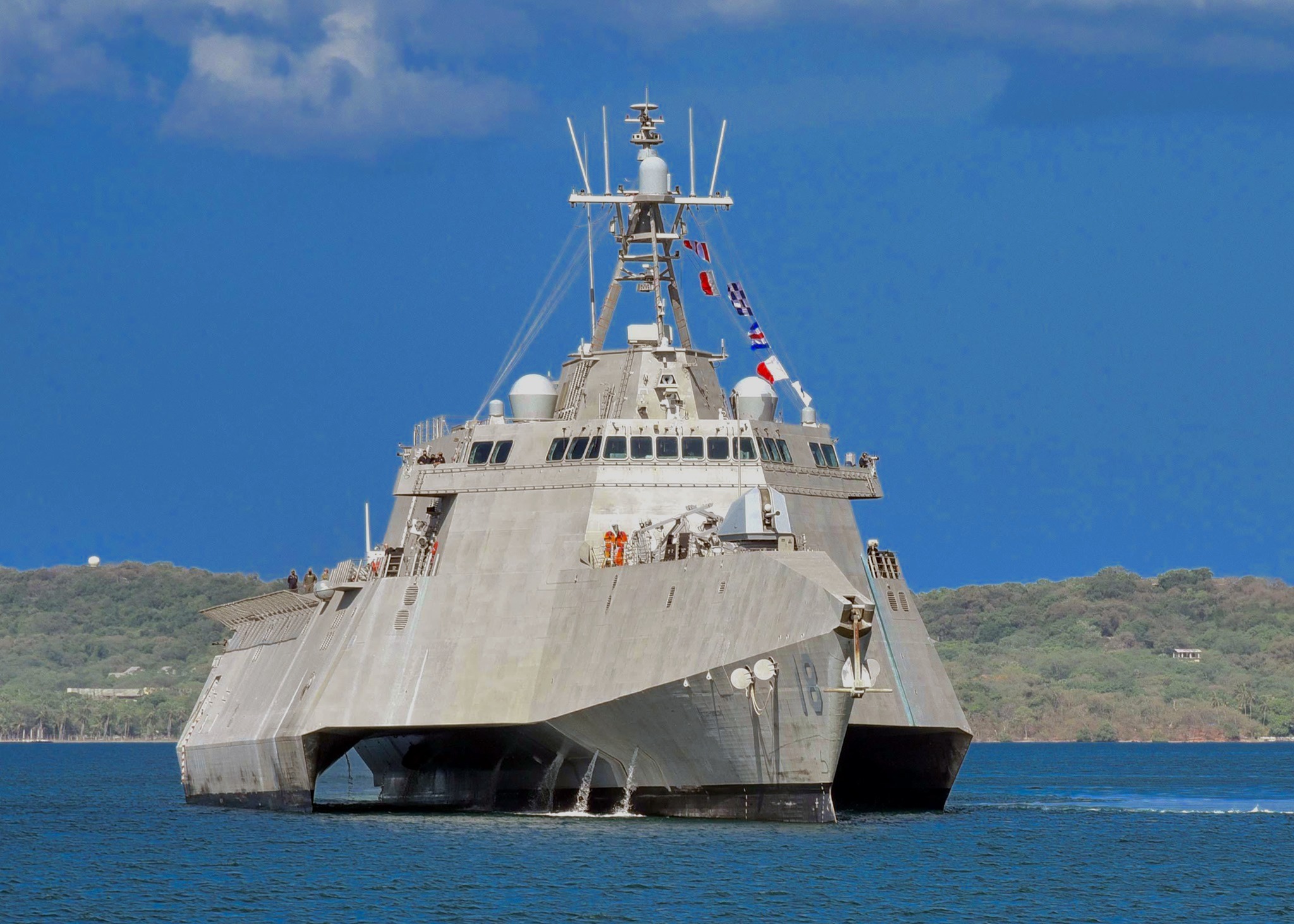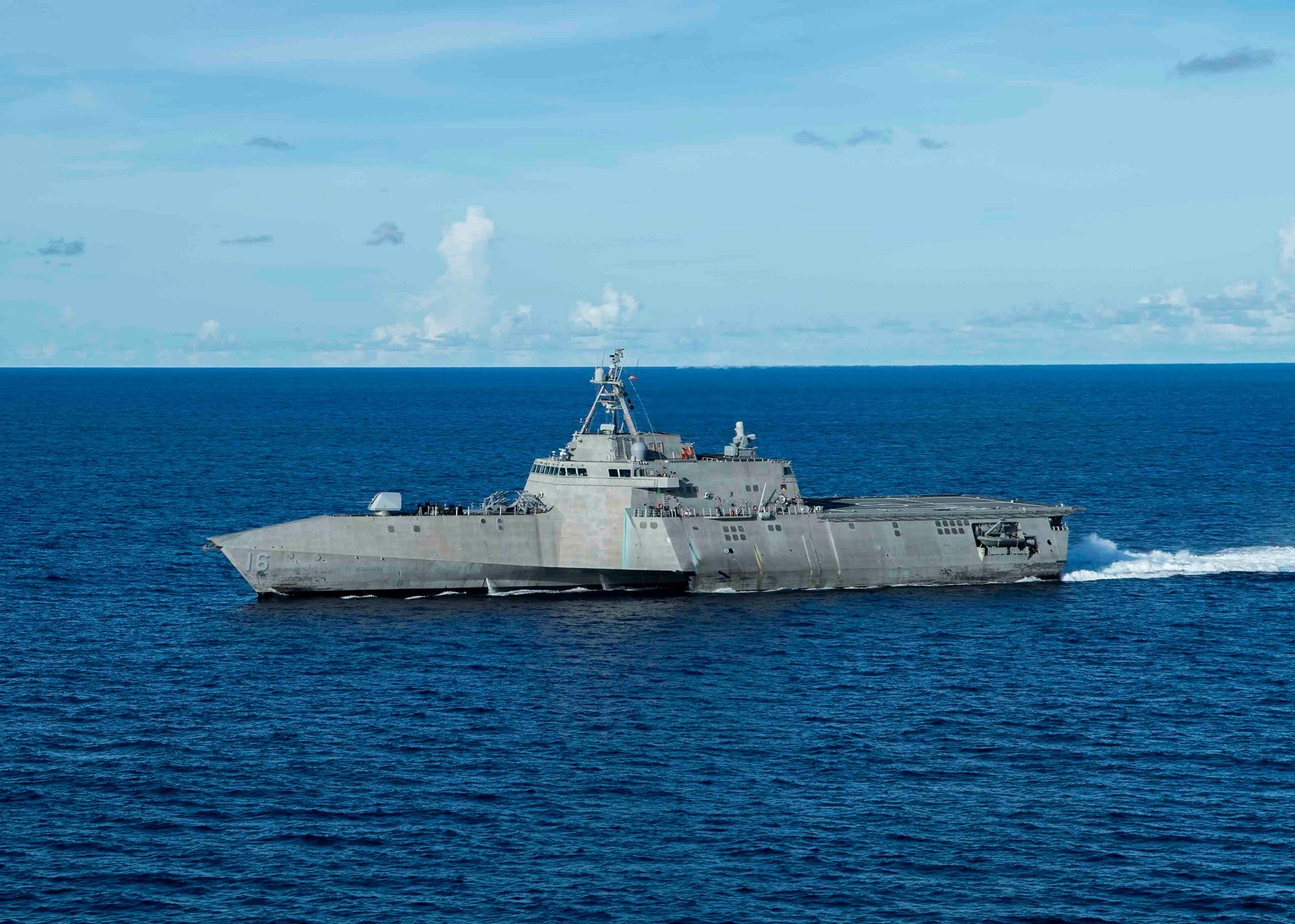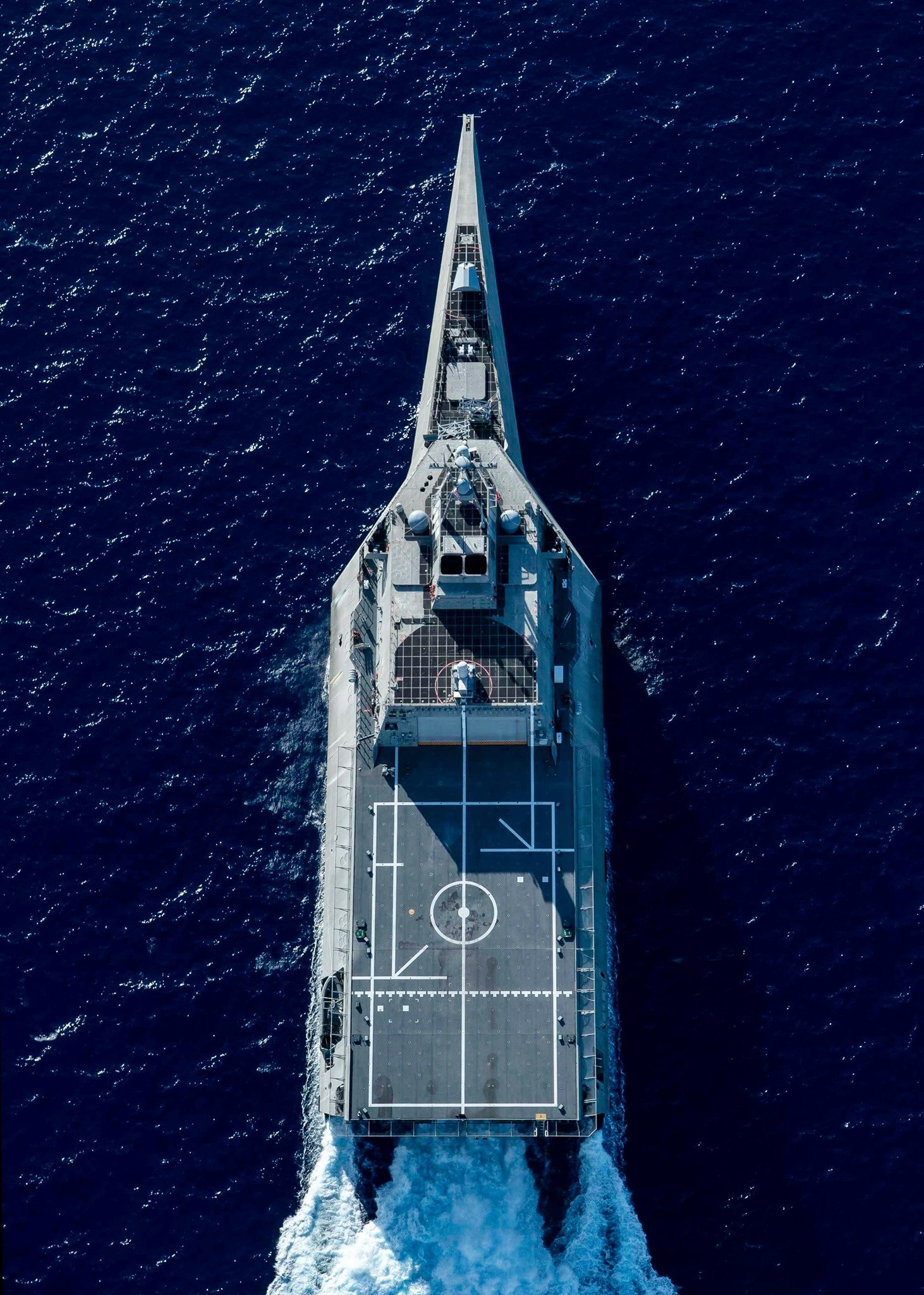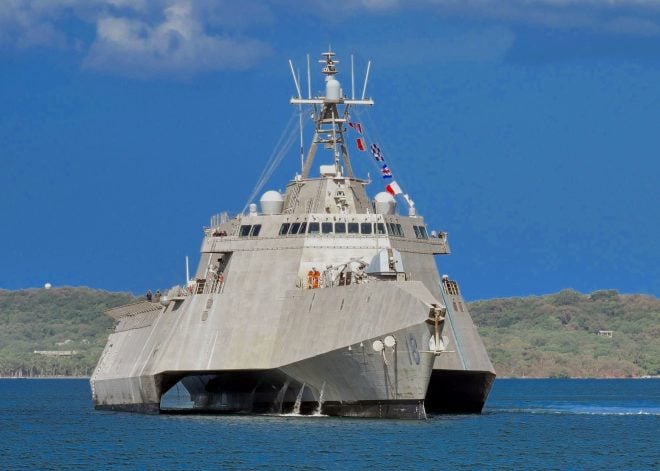Six Littoral Combat Ships to Deploy by Year’s End as Navy Continues to Refine Operations
By: Sam LaGroneJune 28, 2021 9:18 PM

USS Charleston (LCS-18) arrives for a contactless port visit ahead of Cooperation Afloat Readiness and Training (CARAT) Sri Lanka on June 23, 2021. US Navy Photo
The Navy will have six Littoral Combat Ships deployed by the end of the year – a record for the program, several Navy officials have confirmed to USNI News.
Later this year, two Independence-class LCS will join USS Tulsa (LCS-16) and USS Charleston (LCS-18) in the Western Pacific. The two ships kicked off an expansive deployment across the Western Pacific earlier this year that began in Oceana and has ranged to as far as the Indian Ocean. Two other LCS will deploy soon to U.S. Southern Command later this year.
The deployments come as the service has begun to better understand how to use the two LCS variants. Two commanders recently told USNI News how they are improving the reliability of the platforms and refining how to deploy the ships.
Within the last year, seven LCS have operated in U.S. 4th Fleet as part of a counter-narcotics force expansion that began in 2020, 4th Fleet Commander Rear Adm. Donald Gabrielson told USNI News in a June interview.
“As a platform, [LCS] got a lot of utility in the kind of work that we’re doing, which from a naval perspective is about building the capacity and the capability of our partners in the region,” Gabrielson said.
“We’ve got lot of successes on that front. The ships are doing the other things that people would expect here as well – the detection and monitoring with the [Joint Interagency Task Force] South counter-narcotic mission, which also includes a lot of partner interaction. We’ve got 23 different nations that are connected to that effort.”
In addition to the counter-narcotic effort, LCS was key to expanding how the U.S. worked with partners in the region. Most of the forces the U.S. operates with in the region have smaller ships that work more easily with LCS than the Arleigh Burke-class guided-missile destroyers that are three times the tonnage of both classes of LCS, he said.

USS Tulsa (LCS-16) conducts routine operations in the Philippine Sea on June 13, 2021. US Navy Photo
“If you look at how our partners are operating, it’s kind of amazing. They have these tiny boats that are out there for weeks at a time – pretty far off the coast, even, you know, several hundred miles in some cases for a couple of them,” Gabrielson said.
“The advantage that LCS has is the size and the draft of the ship. [Those] enabled it to get into places where other ships cannot.”
In the Western Pacific, the Navy has found that the Independence-class ships USS Montgomery (LCS-8) and USS Gabrielle Giffords (LCS-10) have opened up places for the Navy to operate where they had not been for years, Capt. Tom Ogden, commander of the Singapore-based Destroyer Squadron 7, told reporters earlier this month.
“Gabby Giffords and Montgomery did stops, pre-COVID, in ports that we hadn’t been in a number of years. Puerto Princesa in the Philippines was one of them,” he said.
“The ability for the ship, with the steerable water jets that they have, even with less powerful tugs, you can do a lot of things on your own. Getting a DDG in and out of an austere port requires a little bit more support.”
In U.S. 7th Fleet, the Navy has operated its LCS out of the Changi base in Singapore, but is looking to expand to other places in the region, Japan-based fleet commander Vice Adm. Bill Merz said in May.
“Do we want to keep them in Sasebo, [Japan]? We’re kind of done parking things in the first island chain if I can avoid it,” he said.
“Right now, it’s still Singapore because that’s where the maintenance model is.”

The Freedom-variant littoral combat ship USS Sioux City (LCS 11), transits the Caribbean Sea, April 10, 2021. Sioux City is deployed to the U.S. 4th Fleet area of operations to support Joint Interagency Task Force South’s mission, which includes counter-illicit drug trafficking missions in the Caribbean and Eastern Pacific. US Navy Photo
As originally envisioned, LCS would be supported by contractor-led maintenance while they were forward deployed, but the service is moving toward more sailor-led maintenance. For example, the service positioned a maintenance team in Guam, Ogden said.
“The last two availabilities that we had on Tulsa and Charleston on Guam, we had maintenance execution teams from the LCS division 12 in San Diego. They came out and conducted maintenance on the ship,” he said.
“Not only did they do all the checks that were scheduled for them to complete, they completed checks that had been deferred in availabilities in the past … They’re building a level of knowledge and understanding of the equipment, which allows them to not only need new preventive maintenance, but then corrective maintenance as needed. The maintenance execution team expansion is a huge step forward.”
While maintenance is improving, it’s still not perfect, Merz said in May.
“I’m [not] okay or happy with the sustainability of LCS. That has to be fixed,” he said.

Upcoming MCM package components. Navy Image
In 4th Fleet, maintenance is at the forefront of operating in the region. “The challenge for us or the, or the necessity for us is to develop the facilities piece of this in terms of the footprint for the maintenance,” Gabrielson said.
The Navy is beginning to slowly bring additional mine countermeasures and surface warfare capabilities into the Western Pacific.
For the Independence-class ships headed to 7th Fleet, that means each ship would deploy with the capability to field the anti-ship Naval Strike Missile and parts of the MCM mission package – a grab-bag of anti-sea mine capabilities that are being developed for LCS to replace several legacy MCM platforms.
Every ship that deploys to 7th Fleet now has some combination of the MCM mission package board and works in coordination with MCM Squadron 7 based in Japan, Ogden said.
“Tulsa and Charleston both deployed with versions of the mine warfare, or the mine-countermeasure mission module. They have systems onboard that allow them to do mine hunting, and mine warfare,” he said.
“We’re able to think through the command and control, the tactical availability, and how we would use a multi-mission ship to do maritime warfare, and mine warfare, at the right time and in the right spot. And so, [we’re] integrating with the capabilities that come with LCS, the expertise that MCMRON 7 has, then I would say the expertise and the capabilities that some other [larger] task forces have.”

USS Tulsa (LCS 16) conducts routine operations in the Philippine Sea on June 13, 2021. US Navy Photo
The Navy has backed away from its previous plan to have mission package sailors augment a core crew of sailors trained to just run the ship.
“When a crew is on board it’s not separate from the core crew and the mission package, they are one, and they are a team that stays through no matter which ship they’re on or which hull they’re on at the time they are one crew,” he said.
Ogden would not go into detail on the crew makeup, but LCS deploy with a total of 94 sailors – 70 for the core crew, including the MCM force, and an additional 24 that make up the aviation detachment for the MH-60 aboard, a Navy official confirmed to USNI News.
With more LCS moving into the fleet, Gabrielson said that the ships’ experiences in SOUTHCOM – particularly in counter-narcotics missions – are offering new lessons for LCS in other places around the globe.
“We spend every single day trying to find people that are trying to not be found in waters that are not easy to always operate in,” he said.
“They’re trying to take advantage of the terrain and the geography and they’re well-resourced. If we can find those guys, well, it’s going to make problems in other parts of the world much more solvable for us.”

Six Littoral Combat Ships to Deploy by Year's End as Navy Continues to Refine Operations - USNI News
The Navy will have six Littoral Combat Ships deployed by the end of the year – a record for the program, several Navy officials have confirmed to USNI News. Later this year, two Independence-class LCS will join USS Tulsa (LCS-16) and USS Charleston (LCS-18) in the Western Pacific. The two ships...


